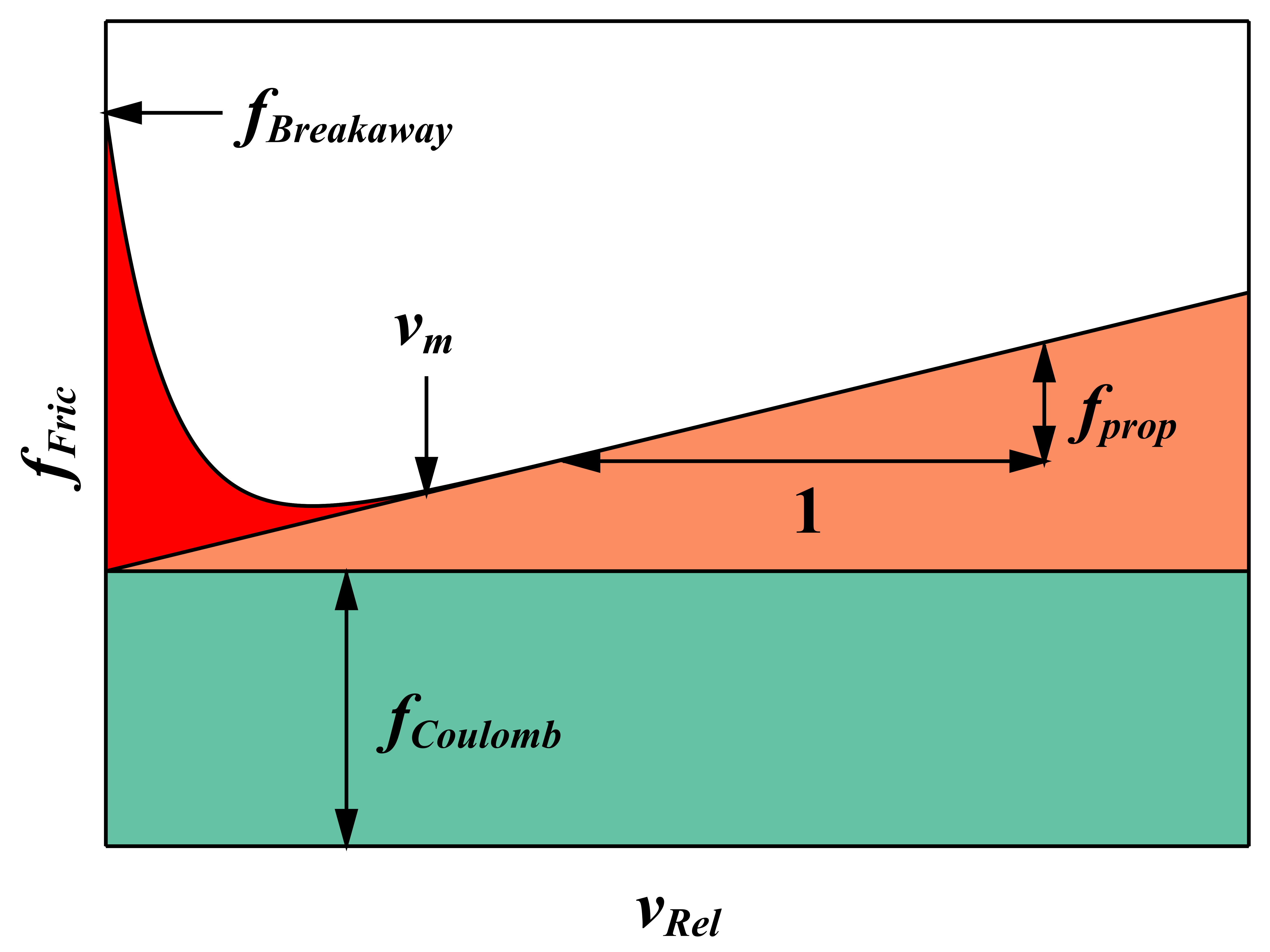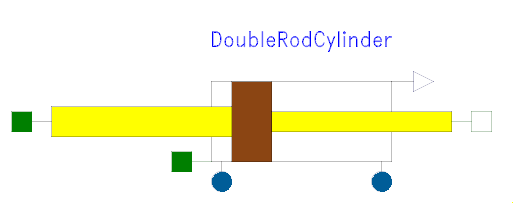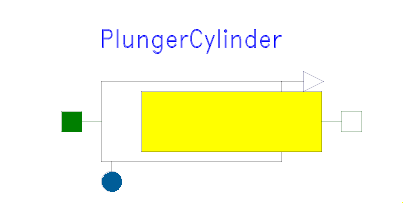 Package HydraulicsByFluidon.Components.Cylinders
Package HydraulicsByFluidon.Components.CylindersIcon for standard packages
 Package HydraulicsByFluidon.Components.Cylinders
Package HydraulicsByFluidon.Components.Cylinders
Standard package icon.
Extends from Modelica.Icons.Package (Icon for standard packages).
| Name | Description |
|---|---|
Cylinder | |
DoubleRodCylinder | |
PlungerCylinder |
 Model HydraulicsByFluidon.Components.Cylinders.Cylinder
Model HydraulicsByFluidon.Components.Cylinders.Cylinder
Model of a differential cylinder with Stribeck friction and volumetric losses.
The fundamental geometrical properties of the differential cylinder are the piston and rod diameters (Piston diameter and Rod diameter) as well as the lengths of the cylinder and the rod (Cylinder length and Rod length). By using the parameter Inclination angle, the inclination of the cylinder with respect to the horizon can be adjusted. The resulting forces due to gravity are taken into account automatically, however without inclusion of static fluid masses.
For dynamic calculations, the masses of the piston and the cylinder are required. These can be provided by specifying the parameters Piston mass and Cylinder mass. The dynamic mass of the fluid, which acts as an additional inertia, is automatically taken into account by the model.
The parameters Breakaway friction force, Constant friction/Coulomb force, Velocity dependent friction and Velocity parameter for Stribeck friction (velocity where the friction force begins to grow linearly) characterize the velocity dependence of the friction force between piston and cylinder. Instead of using the Stribeck friction model, a simplified friction calculation can be enabled by setting the check mark relFric. In this case, the friction force equals the net force acting on the interface between piston and cylinder multiplied by the parameter Relative friction factor. Regardless of which friction model is used, the friction force is not influenced by the inclination of the cylinder or the system pressure. The parameter Relative velocity near to zero is used by the internal state machine of the cylinder model and determines the velocity below which the piston is considered stuck.

The pressure in both cylinder chambers can be initialized by assigning start values to Pressure in chamber A (bore side) and Pressure in chamber B (rod side). The parameter Dead volume determines the size of the parasitic volume which remains even if the piston has reached the mechanical stops at the cylinder ends.
The volumetric losses due to internal and external leakage are parameterized by providing the respective flow rates (Internal leakage: volume flow and External leakage: volume flow), associated pressure drops (Internal leakage: pressure difference and External leakage: pressure difference) and the fluid density Reference density for volume flow and pressure difference for which these values were obtained.
The fluid properties can be propagated between the two hydraulic ports by setting the parameter Forward fluid properties to "true".
| Type | Name | Default | Description |
|---|---|---|---|
Length | pistonDiameter | 0.1 | Piston diameter |
Length | rodDiameter | 0.05 | Rod diameter |
Length | cylinderLength | 0.4 | Cylinder length |
Length | rodLength | 0.4 | Rod length |
Angle | angle | 0 | Inclination angle |
Volume | deadVolume | 1e-4 | Dead volume |
Mass | massPiston | 50 | Piston mass |
Mass | massCylinder | 40 | Cylinder mass |
Real | fProp | 10000 | Velocity dependent friction |
Force | fCoulomb | 250 | Constant friction/Coulomb force |
Force | fBreakaway | 500 | Breakaway friction force |
Velocity | vM | 0.005 | Velocity parameter for Stribeck friction |
Boolean | relFric | false | Use "relative friction factor" to calculate friction |
Real | relFricFactor | 0 | Relative friction factor |
Velocity | vSmall | 1e-4 | Relative velocity near to zero |
VolumeFlowRate | leakageFlowRateInternal | 1.67e-8 | Internal leakage: volume flow |
Pressure | leakagePressureDiffInternal | 1e+7 | Internal leakage: pressure difference |
VolumeFlowRate | leakageFlowRateExternal | 0 | External leakage: volume flow |
Pressure | leakagePressureDiffExternal | 1e+7 | External leakage: pressure difference |
Density | leakageReferenceDensity | 860 | Reference density for volume flow and pressure difference |
Boolean | forwardFluidProperties | false | Forward fluid properties between ports |
| Type | Name | Description |
|---|---|---|
Flange_a | flange_c | |
Flange_b | flange_p | |
FluidPort | fluidPortA | Hydraulic port A |
FluidPort | fluidPortB | Hydraulic port B |
output RealOutput | strokeOut | Relative position of piston |
 Model HydraulicsByFluidon.Components.Cylinders.DoubleRodCylinder
Model HydraulicsByFluidon.Components.Cylinders.DoubleRodCylinder
Model of a double rod cylinder with Stribeck friction and volumetric losses.
The fundamental geometrical properties of the double rod cylinder are the piston and rod diameters (pistonDiameter, rodDiameterA, rodDiameterB) as well as the lengths of the cylinder and the rod (cylinderLength and rodLength). By using the parameter angle, the inclination of the cylinder with respect to the horizon can be adjusted. The resulting forces due to gravity are taken into account automatically, however without inclusion of static fluid masses.
For dynamic calculations, the masses of the piston and the cylinder are required. These can be provided by specifying the parameters Piston mass and Cylinder mass. The dynamic mass of the fluid, which acts as an additional inertia, is automatically taken into account by the model.
The parameters Breakaway friction force, Constant friction/Coulomb force, Velocity dependent friction and Velocity parameter for Stribeck friction (velocity where the friction force begins to grow linearly) characterize the velocity dependence of the friction force between piston and cylinder. Instead of using the Stribeck friction model, a simplified friction calculation can be enabled by setting the check mark relFric. In this case, the friction force equals the net force acting on the interface between piston and cylinder multiplied by the parameter Relative friction factor. Regardless of which friction model is used, the friction force is not influenced by the inclination of the cylinder or the system pressure. The parameter Relative velocity near to zero is used by the internal state machine of the cylinder model and determines the velocity below which the piston is considered stuck.

The pressure in both cylinder chambers can be initialized by assigning start values to Pressure in chamber A (bore side) and Pressure in chamber B (rod side). The parameter Dead volume determines the size of the parasitic volume which remains even if the piston has reached the mechanical stops at the cylinder ends.
The volumetric losses due to internal and external leakage are parameterized by providing the respective flow rates (Internal leakage: volume flow and External leakage: volume flow), associated pressure drops (Internal leakage: pressure difference and External leakage: pressure difference) and the fluid density Reference density for volume flow and pressure difference for which these values were obtained.
The fluid properties can be propagated between the two hydraulic ports by setting the parameter Forward fluid properties to "true".
| Type | Name | Default | Description |
|---|---|---|---|
Length | pistonDiameter | 0.1 | Piston diameter |
Length | rodDiameterA | 0.05 | Rod diameter @ port A |
Length | rodDiameterB | 0.05 | Rod diameter @ port B |
Length | cylinderLength | 0.4 | Cylinder length |
Length | rodLengthA | 0.4 | Rod length @ port A |
Length | rodLengthB | 0.4 | Rod length @ port B |
Angle | angle | 0 | Inclination angle |
Volume | deadVolume | 1e-4 | Dead volume |
Mass | massPiston | 50 | Piston mass |
Mass | massCylinder | 40 | Cylinder mass |
Real | fProp | 10000 | Velocity dependent friction |
Force | fCoulomb | 250 | Constant friction/Coulomb force |
Force | fBreakaway | 500 | Breakaway friction force |
Velocity | vM | 0.005 | Velocity parameter for Stribeck friction |
Boolean | relFric | false | Use "relative friction factor" to calculate friction |
Real | relFricFactor | 0 | Relative friction factor |
Velocity | vSmall | 1e-4 | Relative velocity near to zero |
VolumeFlowRate | leakageFlowRateInternal | 1.67e-8 | Internal leakage: volume flow |
Pressure | leakagePressureDiffInternal | 1e+7 | Internal leakage: pressure difference |
VolumeFlowRate | leakageFlowRateExternal | 0 | External leakage: volume flow |
Pressure | leakagePressureDiffExternal | 1e+7 | External leakage: pressure difference |
Density | leakageReferenceDensity | 860 | Reference density for volume flow and pressure difference |
Boolean | forwardFluidProperties | false | Forward fluid properties between ports |
| Type | Name | Description |
|---|---|---|
Flange_a | flange_c | Cylinder flange |
Flange_a | flange_pa | Piston flange @ port A |
Flange_b | flange_pb | Piston flange @ port B |
FluidPort | fluidPortA | Hydraulic port A |
FluidPort | fluidPortB | Hydraulic port B |
output RealOutput | strokeOut | Relative position of piston |
 Model HydraulicsByFluidon.Components.Cylinders.PlungerCylinder
Model HydraulicsByFluidon.Components.Cylinders.PlungerCylinder
Model of a plunger cylinder with Stribeck friction and volumetric losses.
The fundamental geometrical properties of the plunger cylinder are the cylinder and plunger diameters (Inner diameter of cylinder, Plunger diameter) as well as the lengths of the cylinder and the plunger (Cylinder length and Plunger length). By using the parameter Inclination angle, the inclination of the cylinder with respect to the horizon can be adjusted. The resulting forces due to gravity are taken into account automatically.
For dynamic calculations, the masses of the plunger and the cylinder are required. These can be provided by specifying the parameters Plunger mass and Cylinder mass. The dynamic mass of the fluid, which acts as an additional inertia, is automatically taken into account by the model.
The parameters Breakaway friction force, Constant friction/Coulomb force, Velocity dependent friction and Velocity parameter for Stribeck friction (velocity where the friction force begins to grow linearly) characterize the velocity dependence of the friction force between piston and cylinder. Instead of using the Stribeck friction model, a simplified friction calculation can be enabled by setting the check mark relFric. In this case, the friction force equals the net force acting on the interface between piston and cylinder multiplied by the parameter Relative friction factor. Regardless of which friction model is used, the friction force is not influenced by the inclination of the cylinder or the system pressure. The parameter Relative velocity near to zero is used by the internal state machine of the cylinder model and determines the velocity below which the piston is considered stuck.

The pressure in the chamber can be initialized by assigning start values to Pressure in chamber A. The parameter Dead volume determines the size of the parasitic volume which remains even if the plunger has reached the mechanical stops at the cylinder ends.
The volumetric losses due to external leakage are parameterized by providing the flow rate (External leakage: volume flow), associated pressure drop (External leakage: pressure difference) and the fluid density Reference density for volume flow and pressure difference for which these values were obtained.
| Type | Name | Default | Description |
|---|---|---|---|
Length | cylinderDiameter | 0.1 | Inner diameter of cylinder |
Length | plungerDiameter | 0.05 | Plunger diameter |
Length | cylinderLength | 0.4 | Cylinder length |
Length | plungerLength | 0.4 | Plunger length |
Angle | angle | 0 | Inclination angle |
Volume | deadVolume | 1e-4 | Dead volume |
Mass | massPlunger | 50 | Plunger mass |
Mass | massCylinder | 40 | Cylinder mass |
Real | fProp | 10000 | Velocity dependent friction |
Force | fCoulomb | 250 | Constant friction/Coulomb force |
Force | fBreakaway | 500 | Breakaway friction force |
Velocity | vM | 0.005 | Velocity parameter for Stribeck friction |
Boolean | relFric | false | Use "relative friction factor" to calculate friction |
Real | relFricFactor | 0 | Relative friction factor |
Velocity | vSmall | 1e-4 | Relative velocity near to zero |
VolumeFlowRate | leakageFlowRateExternal | 0 | External leakage: volume flow |
Pressure | leakagePressureDiffExternal | 1e+7 | External leakage: pressure difference |
Density | leakageReferenceDensity | 860 | Reference density for volume flow and pressure difference |
| Type | Name | Description |
|---|---|---|
Flange_a | flange_c | |
Flange_b | flange_p | |
FluidPort | fluidPortA | Hydraulic port A |
output RealOutput | strokeOut | Relative position of piston |